Application of Fundamental Models for Creep Rupture Prediction of Sanicro 25 (23Cr25NiWCoCu)
Abstract
:1. Introduction
- (a)
- The models should be able to represent the rupture controlling mechanism;
- (b)
- All parameters in the models should be well-defined;
- (c)
- No fitting or adjustable parameters should be used to describe the experimental mechanical data;
- (d)
- The modelling results should be sufficiently precise in order to be used technically.
2. Models and Materials
2.1. Ductile Creep Rupture Models
2.1.1. Stacking Fault Energy Factor fSFE
2.1.2. Precipitation Hardening
2.1.3. Glide and Climb Mobility of Dislocations
2.1.4. Solid Solution Hardening
2.2. Brittle Creep Rupture Models
2.2.1. Grain Boundary Sliding (GBS) Models
2.2.2. Cavity Formation Models
2.2.3. Creep Cavity Growth Models
2.2.4. Brittle Creep Rupture
2.3. Experimental Data Sources
3. Results
3.1. Constants Used in the Calculation
3.2. Precipitation Calculation
3.3. Grain Boundary Sliding (GBS) Displacement
3.4. Creep Rupture Prediction
4. Discussion
5. Conclusions
Author Contributions
Funding
Acknowledgments
Conflicts of Interest
References
- He, J. High Temperature Performance of Materials for Future Power Plants. Ph.D. Thesis, KTH Royal Institute of Technology, Stockholm, Sweden, 2016. [Google Scholar]
- Chai, G.; Forsberg, U. Sanicro 25: An advanced high-strength, heat-resistant austenitic stainless steel. In Materials for Ultra-Supercritical and Advanced Ultra-Supercritical Power Plants; Di Gianfrancesco, A., Ed.; Woodhead Publishing: Cambridge, UK, 2017; pp. 391–421. [Google Scholar]
- Sanvik. Sanicro 25 from Sandvik. Available online: https://www.materials.sandvik/en/materials-center/material-datasheets/tube-and-pipe-seamless/sanicro-25/ (accessed on 29 November 2019).
- Chai, G.; Hernblom, J.; Peltola, T.; Forsberg, U. Creep Behavior in A Newly Developed Heat Resistant Austenitic Stainless Steel. BHM Berg- und Hüttenmännische Mon. 2015, 160, 400–405. [Google Scholar] [CrossRef]
- Creep Behavior of the Newly Developed Advanced Heat Resistant Austenitic Stainless Steel Grade UNS S31035. Available online: https://asmedigitalcollection.asme.org/PVP/proceedings-abstract/PVP2010/49255/421/342713 (accessed on 28 November 2019).
- Maruyama, K.; Abe, F.; Sato, H.; Shimojo, J.; Sekido, N.; Yoshimi, K. On the physical basis of a Larson-Miller constant of 20. Int. J. Press. Vessel. Pip. 2018, 159, 93–100. [Google Scholar] [CrossRef]
- European Creep Collaborative Committee (ECCC) Data Sheets, Vol. Issue 2 Revision 002. Available online: https://www.google.com.hk/url?sa=t&rct=j&q=&esrc=s&source=web&cd=1&ved=2ahUKEwi-8d2Ct47mAhWPwosBHUARBKAQFjAAegQIAxAC&url=http%3A%2F%2Feccc.c-s-m.it%2Fuploaded_files%2Fattachments%2F201904021554197177%2Feccc_data_sheets_2017_i2r002.pdf&usg=AOvVaw3bKqX03cGkwKLFx7nhkECY (accessed on 29 November 2019).
- Holdsworth, S. The European Creep Collaborative Committee (ECCC) approach to creep data assessment. J. Press. Vessel Technol.-Trans. ASME 2008, 130, 6. [Google Scholar] [CrossRef]
- Sandström, R. Fundamental Models for Creep Properties of Steels and Copper. Trans. Indian Inst. Met. 2016, 69, 197–202. [Google Scholar] [CrossRef]
- He, J.; Sandström, R. Basic modelling of creep rupture in austenitic stainless steels. Theor. Appl. Fract. Mech. 2017, 89, 139–146. [Google Scholar] [CrossRef]
- Korzhavyi, P.A.; Sandström, R. First-principles evaluation of the effect of alloying elements on the lattice parameter of a 23Cr25NiWCuCo austenitic stainless steel to model solid solution hardening contribution to the creep strength. Mater. Sci. Eng. A 2015, 626, 213–219. [Google Scholar] [CrossRef]
- Sandström, R.; He, J. Survey of Creep Cavitation in fcc Metals. In Study of Grain Boundary Character; Tanski, T., Borek, W., Eds.; InTechOpen: London, UK, 2017. [Google Scholar]
- Sandström, R. Basic model for primary and secondary creep in copper. Acta Mater. 2012, 60, 314–322. [Google Scholar] [CrossRef]
- Sui, F.; Sandström, R. Creep strength contribution due to precipitation hardening in copper-cobalt alloys. J. Mater. Sci. 2019, 54, 1819–1830. [Google Scholar] [CrossRef]
- Sui, F.; Sandström, R. Basic modelling of tertiary creep of copper. J. Mater. Sci. 2018, 53, 6850–6863. [Google Scholar] [CrossRef]
- Vujic, S.; Sandström, R.; Sommitsch, C. Precipitation evolution and creep strength modelling of 25Cr20NiNbN austenitic steel. Mater. High Temp. 2015, 32, 607–618. [Google Scholar] [CrossRef]
- Argon, A.S.; Moffatt, W.C. Climb of extended edge dislocations. Acta Metall. 1981, 29, 293–299. [Google Scholar] [CrossRef]
- Vitos, L.; Nilsson, J.O.; Johansson, B. Alloying effects on the stacking fault energy in austenitic stainless steels from first-principles theory. Acta Mater. 2006, 54, 3821–3826. [Google Scholar] [CrossRef]
- Li, R.; Lu, S.; Kim, D.; Schonecker, S.; Zhao, J.; Kwon, S.K.; Vitos, L. Stacking fault energy of face-centered cubic metals: Thermodynamic and ab initio approaches. J. Phys. Condens. Matter 2016, 28, 395001. [Google Scholar] [CrossRef] [PubMed]
- Eliasson, J.; Gustafson, A.; Sandstrom, R. Kinetic modelling of the influence of particles on creep strength. Key Eng. Mat. 2000, 171, 277–284. [Google Scholar] [CrossRef]
- Sandström, R.; Farooq, M.; Zurek, J. Basic creep models for 25Cr20NiNbN austenitic stainless steels. Mater. Res. Innov. 2013, 17, 355–359. [Google Scholar] [CrossRef]
- He, J.; Sandström, R. Modelling grain boundary sliding during creep of austenitic stainless steels. J. Mater. Sci. 2016, 51, 2926–2934. [Google Scholar] [CrossRef]
- Sandström, R. Creep strength in austenitic stainless steels. Presented at ECCC 2014 3rd International ECCC Conference, Rome, Italy, 5–7 May 2014. [Google Scholar]
- Sandström, R. The role of cell structure during creep of cold worked copper. Mater. Sci. Eng. A 2016, 674, 318–327. [Google Scholar] [CrossRef]
- Dymáček, P.; Jarý, M.; Dobeš, F.; Kloc, L. Tensile and creep testing of Sanicro 25 using miniature specimens. Materials 2018, 11, 142. [Google Scholar] [CrossRef]
- He, J.; Sandström, R. Formation of creep cavities in austenitic stainless steels. J. Mater. Sci. 2016, 51, 6674–6685. [Google Scholar] [CrossRef]
- He, J.; Sandström, R. Creep cavity growth models for austenitic stainless steels. Mater. Sci. Eng. A 2016, 674, 328–334. [Google Scholar] [CrossRef]
- Needham, N.G.; Gladman, T. Nucleation and growth of creep cavities in a type 347 steel. Met. Sci. 1980, 14, 64–72. [Google Scholar] [CrossRef]
- Čermák, J. Grain boundary self-diffusion of 51Cr and 59Fe in austenitic NiFeCr alloys. Mater. Sci. Eng. A 1991, 148, 279–287. [Google Scholar] [CrossRef]
- High-Temperature Alloys; Clark, C.L. (Ed.) Pitman: New York, NY, USA, 1953. [Google Scholar]
- TCS. TCS Alloy Mobility Database (MOB2). Thermo-Calc Software AB Database Segment: Iron and Steel. Available online: https://www.thermocalc.com/media/6015/dbd_mob2-2.pdf (accessed on 29 November 2019).
- Properties and Selection: Nonferrous Alloys and Special-Purpose Materials; Anderson, K. (Ed.) ASM International: Cleveland, OH, USA, 1991. [Google Scholar]
- Pitkänen, H.; Alatalo, M.; Puisto, A.; Ropo, M.; Kokko, K.; Vitos, L. Ab initio study of the surface properties of austenitic stainless steel alloys. Surf. Sci. 2013, 609, 190–194. [Google Scholar] [CrossRef]
- Rice, J.R. Constraints on the diffusive cavitation of isolated grain boundary facets in creeping polycrystals. Acta Metall. 1981, 29, 675–681. [Google Scholar] [CrossRef]
- Orlová, A. On the relation between dislocation structure and internal stress measured in pure metals and single phase alloys in high temperature creep. Acta Metall. Mater. 1991, 39, 2805–2813. [Google Scholar] [CrossRef]
- Zhang, Z.; Hu, Z.; Tu, H.; Schmauder, S.; Wu, G. Microstructure evolution in HR3C austenitic steel during long-term creep at 650 °C. Mater. Sci. Eng. A 2017, 681, 74–84. [Google Scholar] [CrossRef]
- Gittins, A. The kinetics of cavity growth in 20 Cr25 Ni stainless steel. J. Mater. Sci. 1970, 5, 223–232. [Google Scholar] [CrossRef]
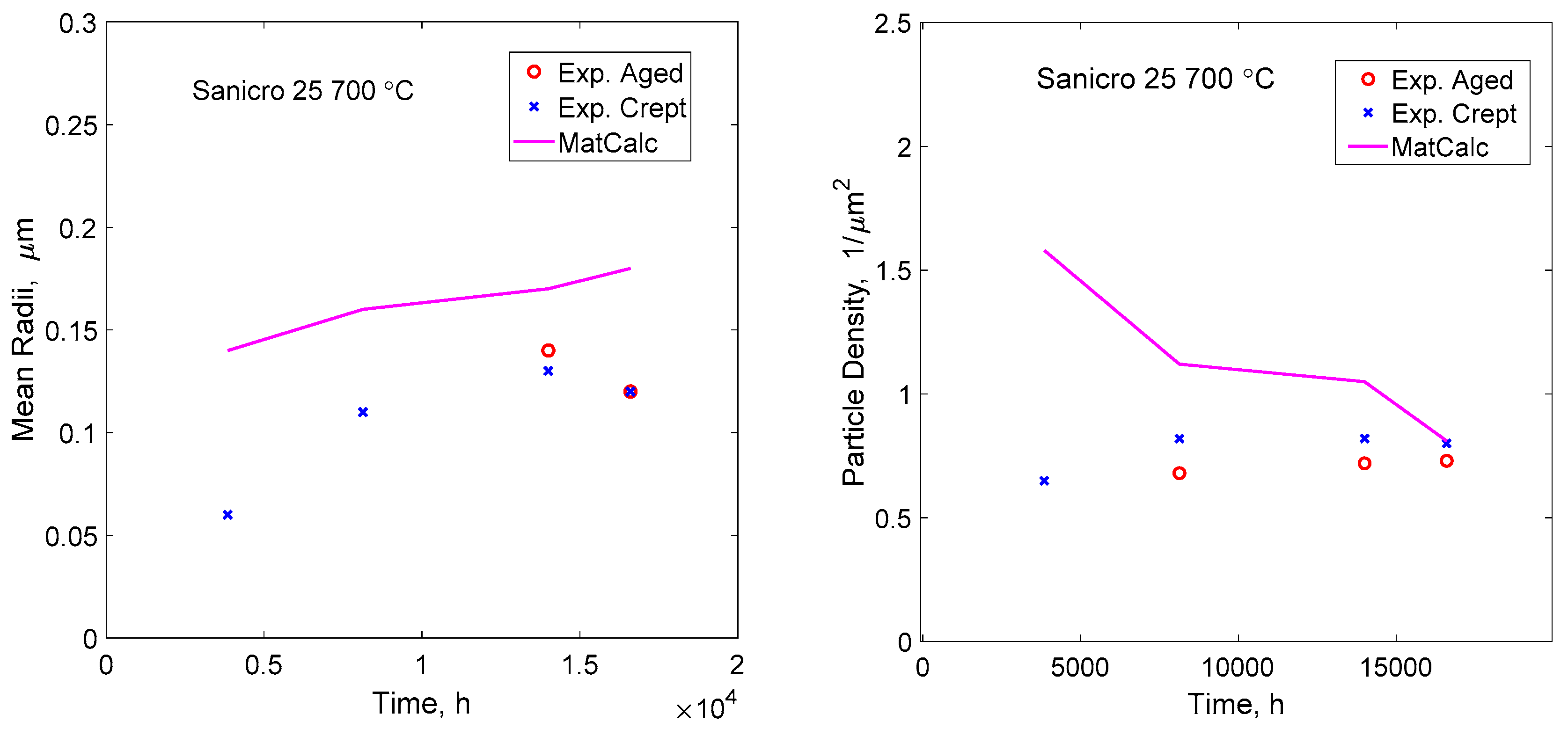
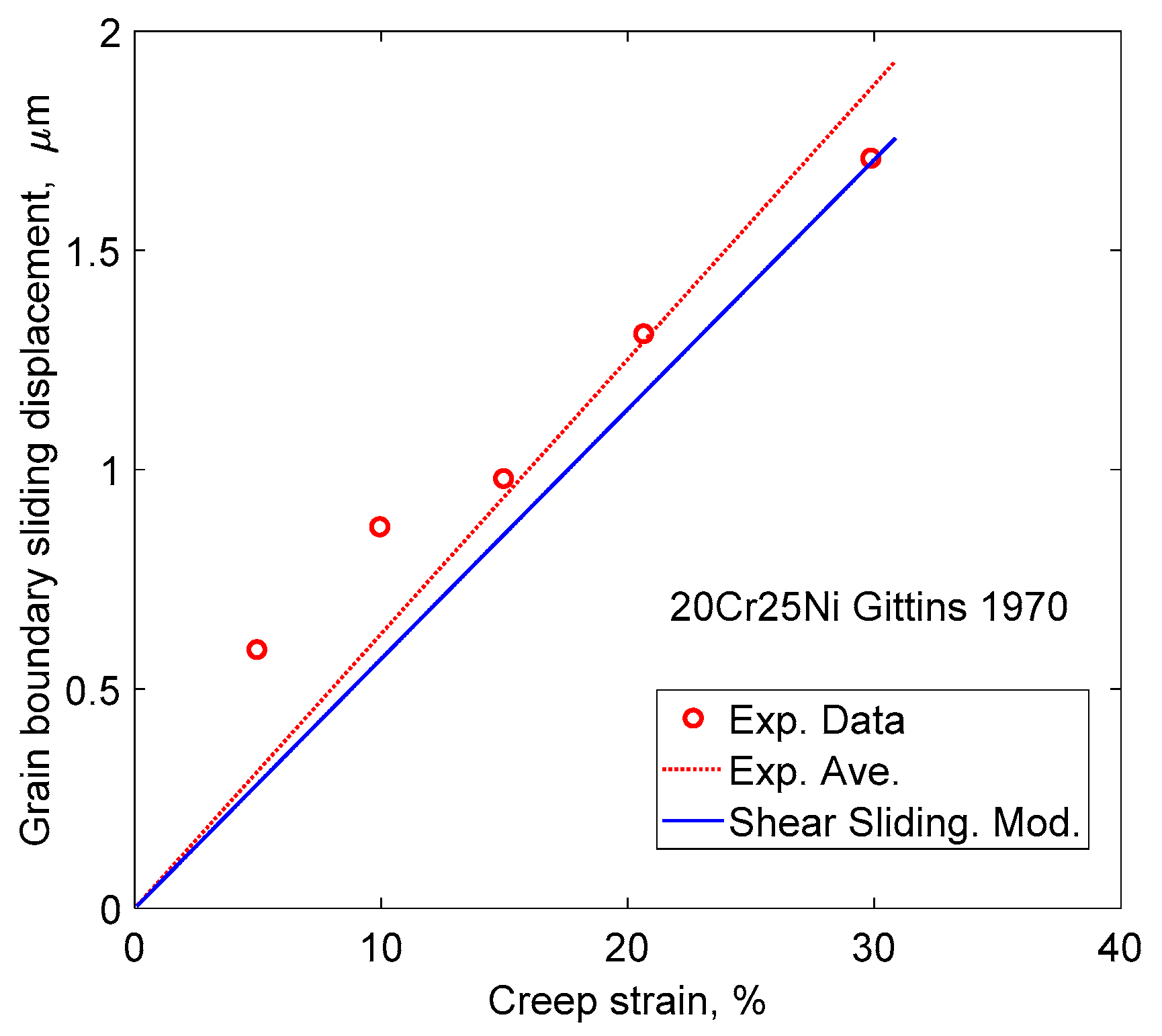
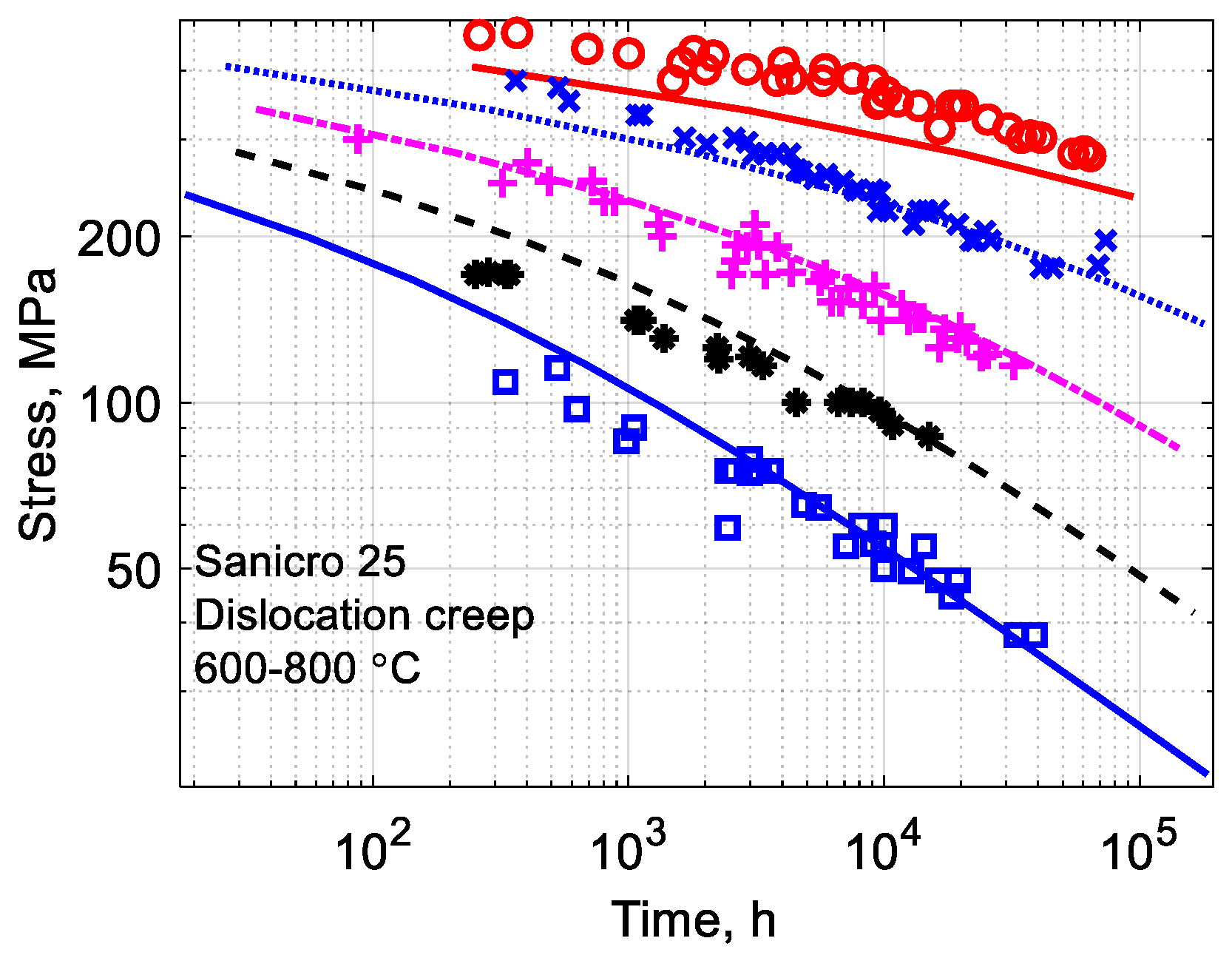
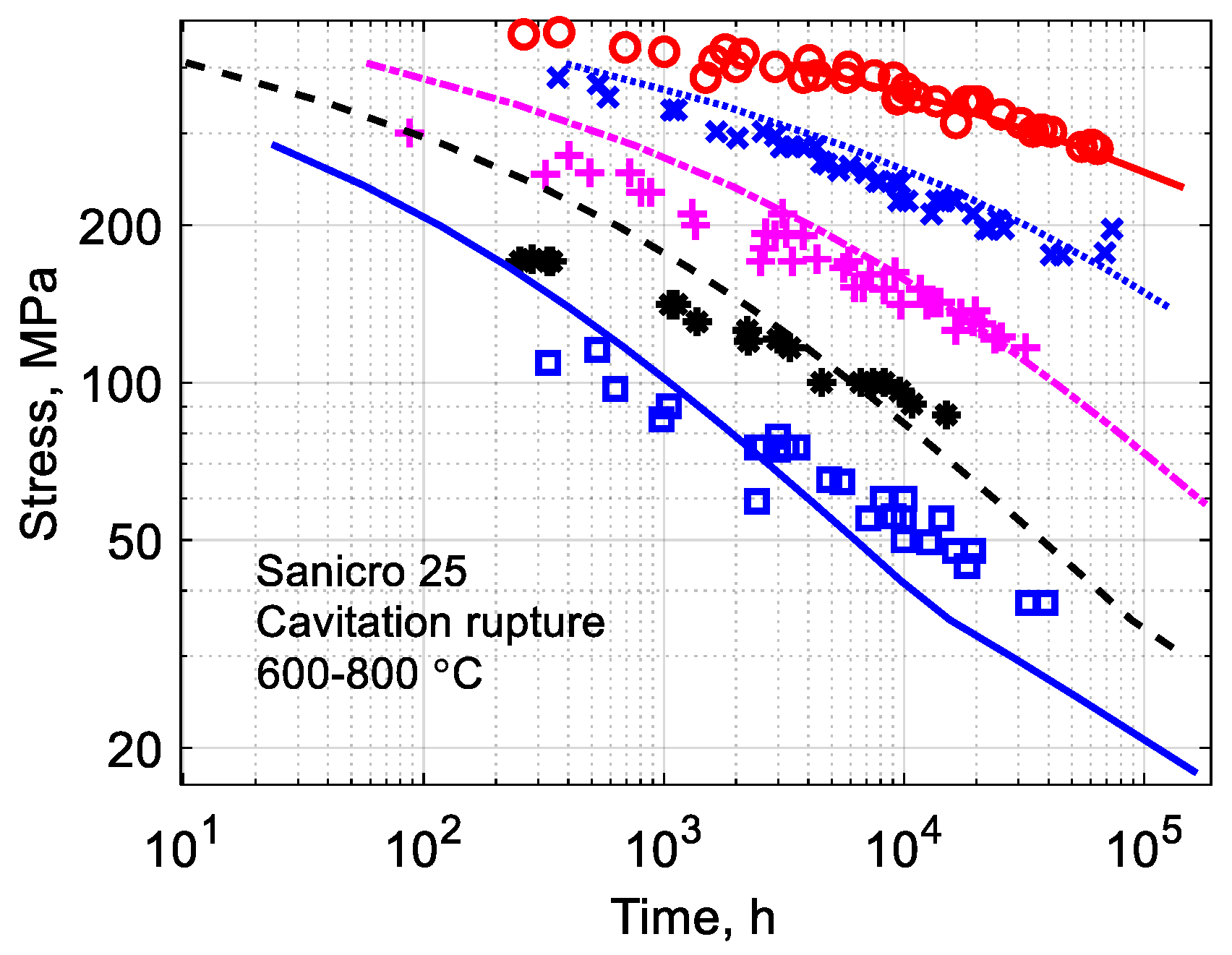
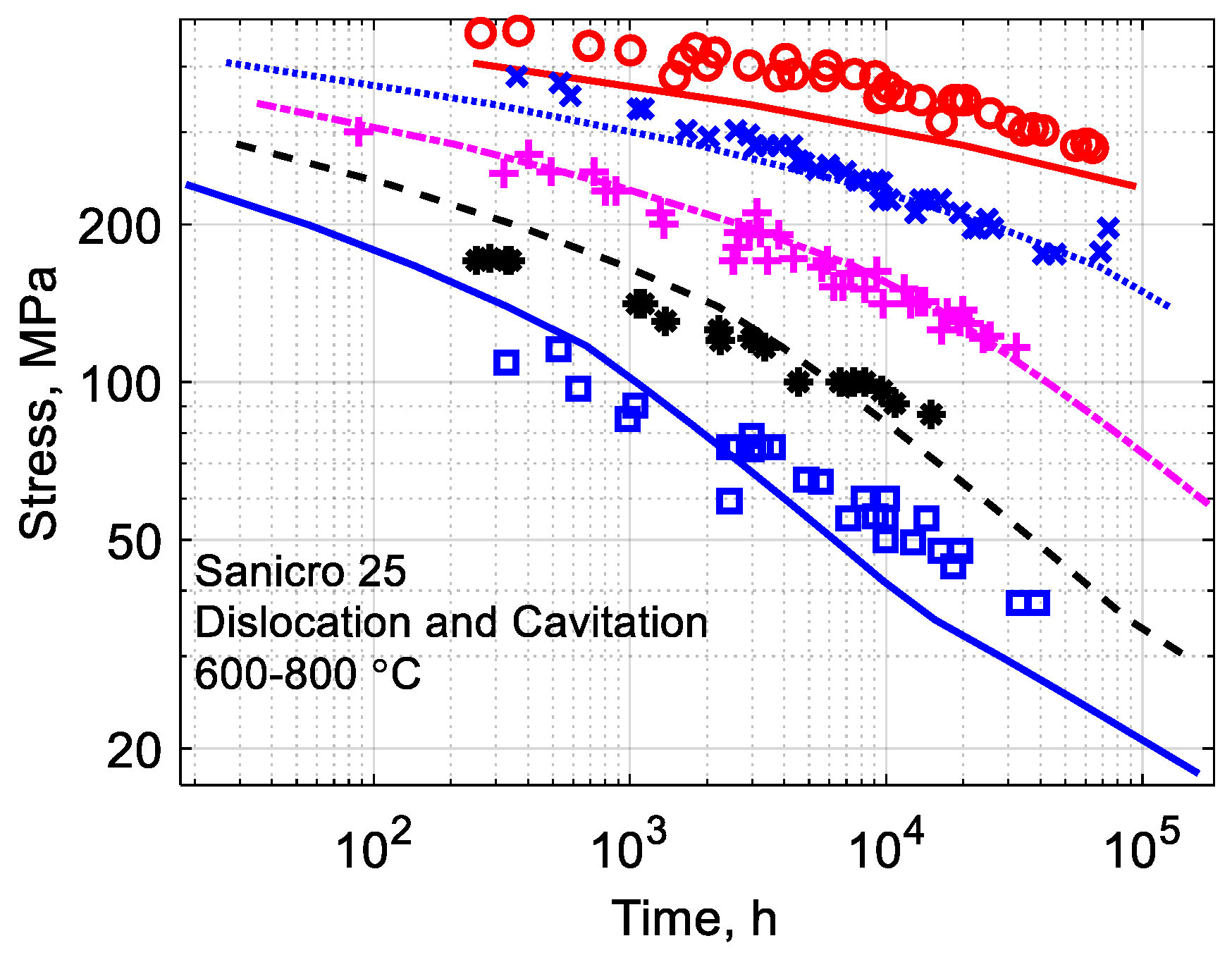
| C | Si | Mn | Cr | Ni | N | W | Co | Cu | P | S | Nb | Fe |
|---|---|---|---|---|---|---|---|---|---|---|---|---|
| 0.064 | 0.2 | 0.5 | 22.5 | 25 | 0.23 | 3.6 | 1.5 | 3.0 | 0.025 | 0.015 | 0.5 | Balance |
| Parameter Description | Parameter | Value | References |
|---|---|---|---|
| Grain boundary diffusion constant | δDGB | [29] | |
| Shear modulus | G | (78 − 0.036 × (T − 273)) × 103 MPa | [30] |
| Activation energy for self-diffusion | Q | 293 kJ mol−1 | [31] |
| Atomic volume | Ω0 | 1.14 × 10−29 m3 | [23] |
| Boltzmann constant | kB | 1.381 × 10−23 J K−1 | |
| Burgers’ vector | b | 2.58 × 10−10 m | |
| Poisson’s ratio | ν | 0.3 | [32] |
| Surface energy | γsurf | 2.8 J m−2 | [33] |
| Cavity tip angle | θ | 70° | [34] |
| Pre-exponential coefficient for self-diffusion | Ds0 | 3.15 × 10−4 m2 s−1 | [31] |
| Taylor factor | m | 3.06 | |
| Work hardening constant | α | (1 − ν/2)/2π(1 − ν) = 0.19 | [35] |
© 2019 by the authors. Licensee MDPI, Basel, Switzerland. This article is an open access article distributed under the terms and conditions of the Creative Commons Attribution (CC BY) license (http://creativecommons.org/licenses/by/4.0/).
Share and Cite
He, J.; Sandström, R. Application of Fundamental Models for Creep Rupture Prediction of Sanicro 25 (23Cr25NiWCoCu). Crystals 2019, 9, 638. https://doi.org/10.3390/cryst9120638
He J, Sandström R. Application of Fundamental Models for Creep Rupture Prediction of Sanicro 25 (23Cr25NiWCoCu). Crystals. 2019; 9(12):638. https://doi.org/10.3390/cryst9120638
Chicago/Turabian StyleHe, Junjing, and Rolf Sandström. 2019. "Application of Fundamental Models for Creep Rupture Prediction of Sanicro 25 (23Cr25NiWCoCu)" Crystals 9, no. 12: 638. https://doi.org/10.3390/cryst9120638
APA StyleHe, J., & Sandström, R. (2019). Application of Fundamental Models for Creep Rupture Prediction of Sanicro 25 (23Cr25NiWCoCu). Crystals, 9(12), 638. https://doi.org/10.3390/cryst9120638





